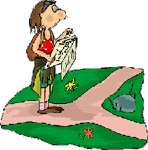|
 MAPS
AS TOOLS MAPS
AS TOOLS
Teacher Outline
* Teacher Outline included in Teacher
Guide Download
I. What is a landform?
The shape of the Earth’s
surface that has been accomplished by erosion or tectonic activity.
-
Influenced by climate and rock type
-
Erosion includes water, ice, glaciers
and heat
-
Tectonic includes earthquakes and
volcanoes
II. Erosion and Weathering
Erosion is the process that
loosens and moves sediment to another place on the Earth’s surface; weathering
is the chemical and mechanical breakdown of rock with little or no
transportation
-
Rocks erode at different rates so
there are areas that are more resistant than others; this can produce
different types of landforms with ridges, cliffs, or gentle slopes
-
Running water erodes areas in
predictable stages depending on the amount of rain and the type of rock it is
eroding; tectonic activity influences this erosion (i.e. Grand Canyon needed
uplifting of rocks for the water to keep eroding downward)
-
Almost every landform on the
continent is related to a drainage system as water finds its way to large
bodies of water
-
water is an overlay of other
features caused by tectonics
-
rivers cause "V" shaped valleys because of the movement of the
sediments downstream
-
Ice is important feature in areas
where it is cold throughout the year, but this is restrictive to the northern
and southern pole areas
-
Ice is more powerful than water for
its erosive forces
-
Glaciers can create U shaped valleys as they abrade the rocks around
them; their flow pattern is like a river
3. Continental or sheet glaciers erode large area, contours are more
difficult to interpret with many different parameters
-
Wind is important is arid areas
-
causes desert polish, where the
rocks are smooth on the side that the wind hits
-
desert pavement where there is polished large pebbles and cobblestones
left; small sediment is removed by wind
-
sand dunes are created as wind drops the sediment in a predictable
pattern
III. Tectonic Activity
-
Movement on the Earth’s crust can
cause earthquakes. The movement is usually along a fault which can move in
many ways.
-
Mountains - one side of the fault
can move upwards
-
Offset streams - as a fault slides away from each other the river will
compensate and become offset
-
Basin and Range - where basins are pulled apart and cause some areas to
go up and some to go down
-
Volcanoes
-
Lava flows can create a landscape
that is made of volcanic rocks. It will cover the pre-existing land to
create a new landscape.
-
Ash flows from erupting volcano can cover vast areas. They can even cover
an entire city (i.e. Pompeii, Italy)
-
Mud flows can form when snow or glaciers are melted and mix with ash. The
flow is very large and can cover huge amount of lands that bury everything
in its path.
IV. How do maps act as a
tool
-
Designing an urban area requires an
understanding of relief
-
Example: creating water or sewage
flow to and from a house, need to incorporate slopes to help gravity flow
the liquid.
-
Designing a road, do not want to make it too steep or trucks cannot drive
-
Do not want to make homes along steep cliffs
-
Workable area
-
A map can be used to develop
different models at a scale that humans can work with
-
A map can be modified, where the real land is more difficult to modify
after changes have been made
|
 MAPS
AS TOOLS
MAPS
AS TOOLS